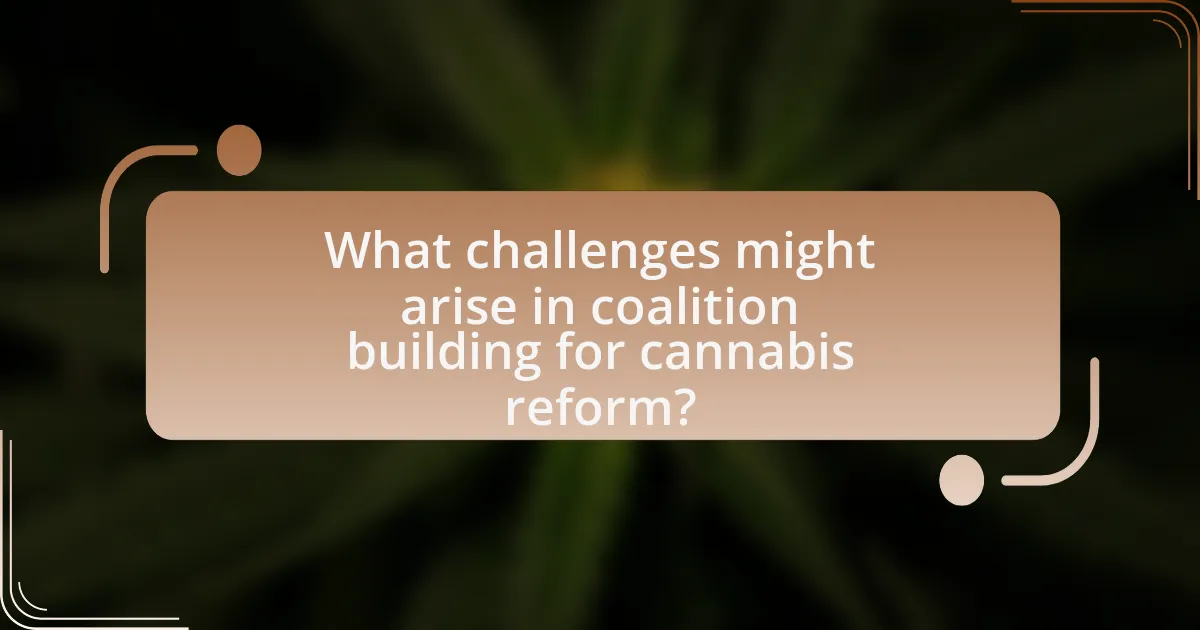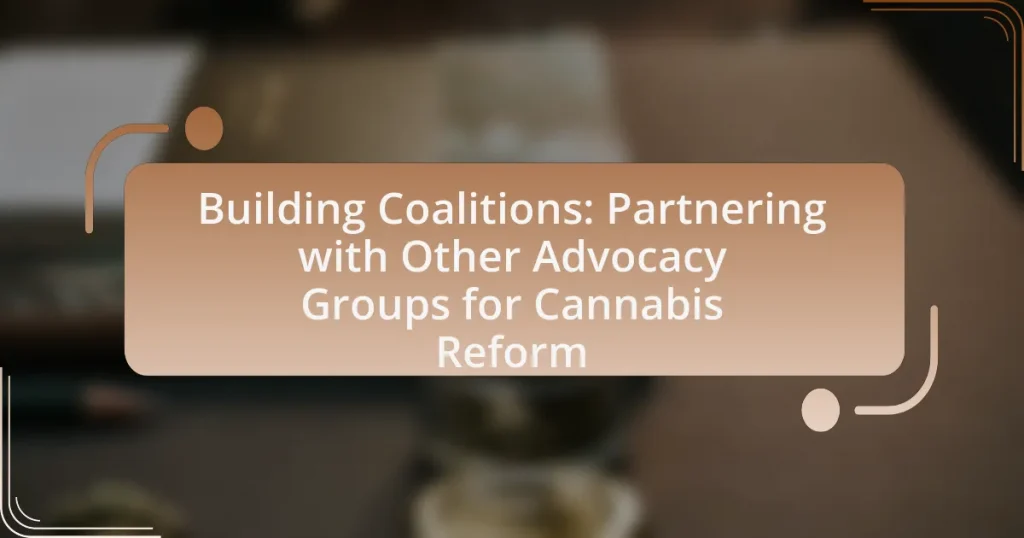The article focuses on the importance of building coalitions among advocacy groups for cannabis reform. It outlines the process of uniting diverse stakeholders, including public health organizations, civil rights groups, and economic interests, to effectively advocate for policy changes. Key components of successful coalitions, such as shared goals, effective communication, and mutual trust, are discussed, along with strategies for fostering collaboration and managing differing agendas. The article also highlights the benefits of partnerships, the challenges faced in coalition building, and best practices to enhance effectiveness in achieving cannabis reform objectives.

What does building coalitions for cannabis reform involve?
Building coalitions for cannabis reform involves uniting various advocacy groups, stakeholders, and community members to collectively push for policy changes regarding cannabis legislation. This process requires identifying common goals, establishing communication channels, and coordinating efforts to amplify their influence on lawmakers. For instance, successful coalitions often include organizations focused on public health, criminal justice reform, and economic development, which can provide diverse perspectives and resources. Research indicates that coalitions can enhance advocacy effectiveness, as seen in states where collaborative efforts have led to significant legislative victories, such as the legalization of medical or recreational cannabis.
Why are coalitions important for cannabis reform?
Coalitions are important for cannabis reform because they unify diverse stakeholders to advocate for policy changes effectively. By bringing together various advocacy groups, including medical professionals, civil rights organizations, and economic interests, coalitions amplify their collective voice, making it more likely to influence lawmakers. Research indicates that states with strong coalitions have seen more successful cannabis legalization efforts, as evidenced by the passage of laws in states like California and Colorado, where collaborative advocacy played a crucial role in shaping public opinion and legislative outcomes.
What roles do advocacy groups play in these coalitions?
Advocacy groups play crucial roles in coalitions focused on cannabis reform by providing expertise, mobilizing grassroots support, and influencing policy. These organizations often bring specialized knowledge about legal, medical, and social aspects of cannabis, which enhances the coalition’s effectiveness in addressing complex issues. For instance, groups like the Drug Policy Alliance have successfully advocated for policy changes by leveraging their research and public outreach capabilities. Additionally, advocacy groups facilitate collaboration among diverse stakeholders, ensuring that various perspectives are represented, which strengthens the coalition’s overall impact on legislative processes.
How do coalitions enhance the effectiveness of cannabis reform efforts?
Coalitions enhance the effectiveness of cannabis reform efforts by uniting diverse stakeholders to create a stronger, unified voice for advocacy. This collaboration allows for pooling resources, sharing expertise, and amplifying messaging, which increases public awareness and support for reform initiatives. For instance, coalitions can combine the efforts of medical professionals, legal experts, and community organizations, leading to more comprehensive and informed advocacy strategies. Research indicates that states with active coalitions for cannabis reform have seen higher rates of successful legislative changes, demonstrating the tangible impact of collective action in this area.
What are the key components of successful coalitions?
The key components of successful coalitions include shared goals, effective communication, mutual trust, and diverse representation. Shared goals ensure that all members are aligned in their objectives, which fosters collaboration and commitment. Effective communication facilitates transparency and understanding among coalition members, allowing for the exchange of ideas and strategies. Mutual trust builds a strong foundation for cooperation, enabling members to rely on one another and work towards common objectives. Diverse representation brings together various perspectives and resources, enhancing the coalition’s ability to address complex issues and appeal to a broader audience. These components are essential for the coalition’s effectiveness in advocating for cannabis reform.
How do shared goals and values influence coalition building?
Shared goals and values significantly enhance coalition building by fostering trust and collaboration among diverse groups. When advocacy organizations for cannabis reform align on common objectives, they create a unified front that amplifies their collective voice and increases their influence. For instance, research shows that coalitions with shared missions are more effective in mobilizing resources and engaging stakeholders, as seen in successful campaigns like the legalization efforts in various U.S. states. This alignment not only streamlines communication but also facilitates strategic planning, making it easier to navigate challenges and achieve desired outcomes.
What strategies can be employed to foster collaboration among groups?
To foster collaboration among groups, establishing clear communication channels is essential. Effective communication ensures that all parties understand their roles, objectives, and the overall mission, which is crucial in coalition-building for cannabis reform. Research indicates that organizations that prioritize open dialogue and regular updates experience higher levels of engagement and cooperation among members. For instance, a study by the National Council of Nonprofits highlights that organizations with structured communication strategies report a 30% increase in collaborative efforts. Additionally, setting shared goals and objectives aligns the interests of diverse groups, creating a unified direction that enhances collaboration.

How can advocacy groups identify potential partners?
Advocacy groups can identify potential partners by conducting thorough research on organizations that share similar goals and values related to cannabis reform. This involves analyzing existing coalitions, reviewing public statements, and assessing the missions of various groups to find alignment in objectives. For instance, groups can utilize databases like Guidestar or the National Council of Nonprofits to locate organizations focused on drug policy reform, public health, or social justice, which often intersect with cannabis advocacy. Additionally, attending relevant conferences and networking events can facilitate direct connections with like-minded organizations, enhancing partnership opportunities.
What criteria should be considered when selecting coalition partners?
When selecting coalition partners for cannabis reform, organizations should consider shared goals, values, and mission alignment. This ensures that all partners are committed to the same objectives, which enhances collaboration and effectiveness. Additionally, assessing the partner’s credibility and reputation within the community is crucial, as it impacts the coalition’s overall trustworthiness and influence. The partner’s resources, including financial stability and human capital, should also be evaluated to ensure they can contribute meaningfully to the coalition’s efforts. Furthermore, understanding the partner’s network and reach can amplify advocacy efforts, making it essential to consider their connections and influence in relevant sectors. Lastly, evaluating past collaboration experiences can provide insights into the partner’s reliability and commitment to collective action.
How can groups assess alignment in mission and vision?
Groups can assess alignment in mission and vision by conducting a thorough analysis of their core values, objectives, and strategic goals in relation to those of potential partners. This process involves comparing mission statements and vision descriptions to identify common themes and objectives. For instance, a study by the Stanford Social Innovation Review highlights that organizations can utilize tools like mission alignment matrices to visually map out similarities and differences, facilitating discussions on shared goals. Additionally, engaging in open dialogues and workshops can help clarify intentions and ensure that all parties are committed to a unified direction, thereby enhancing collaboration in advocacy efforts for cannabis reform.
What methods can be used to evaluate the strengths of potential partners?
To evaluate the strengths of potential partners in cannabis reform advocacy, organizations can utilize methods such as SWOT analysis, due diligence assessments, and stakeholder mapping. SWOT analysis identifies strengths, weaknesses, opportunities, and threats related to potential partners, providing a comprehensive view of their capabilities and alignment with advocacy goals. Due diligence assessments involve reviewing a partner’s financial health, reputation, and past performance, ensuring that they possess the necessary resources and credibility. Stakeholder mapping helps visualize the influence and relationships of potential partners within the advocacy landscape, allowing organizations to identify those with the most significant impact and shared objectives. These methods collectively enable organizations to make informed decisions about potential partnerships, enhancing the effectiveness of coalitions in cannabis reform efforts.
What are the benefits of partnering with other advocacy groups?
Partnering with other advocacy groups enhances the effectiveness of cannabis reform efforts by pooling resources, expertise, and networks. This collaboration allows for a broader reach and increased visibility, which can amplify the message and attract more supporters. For instance, joint campaigns can leverage the unique strengths of each organization, such as specialized knowledge or established community ties, leading to more impactful advocacy. Additionally, research indicates that coalitions can improve the likelihood of achieving policy changes, as seen in various successful reform movements where unified efforts led to legislative victories.
How can coalitions amplify the voices of marginalized communities in cannabis reform?
Coalitions can amplify the voices of marginalized communities in cannabis reform by uniting diverse advocacy groups to create a stronger, collective platform for change. This collaboration allows for shared resources, increased visibility, and a unified message that highlights the specific needs and concerns of marginalized populations affected by cannabis policies. For instance, coalitions can leverage data showing that communities of color are disproportionately impacted by cannabis prohibition, thereby advocating for equitable reform that addresses these disparities. By combining efforts, coalitions can effectively influence legislation and public opinion, ensuring that the voices of marginalized communities are not only heard but prioritized in the cannabis reform dialogue.
What resources can be shared among coalition partners to enhance impact?
Coalition partners can share various resources such as research data, advocacy tools, funding opportunities, and communication platforms to enhance impact. Sharing research data allows partners to leverage evidence-based insights, which can strengthen their collective arguments for cannabis reform. Advocacy tools, including campaign materials and training programs, enable partners to effectively mobilize support and educate stakeholders. Access to shared funding opportunities can amplify financial resources for joint initiatives, while communication platforms facilitate coordinated messaging and outreach efforts. These shared resources collectively enhance the coalition’s ability to influence policy and public perception regarding cannabis reform.

What challenges might arise in coalition building for cannabis reform?
Challenges in coalition building for cannabis reform include differing priorities among advocacy groups, potential conflicts over strategies, and varying levels of commitment to reform goals. Advocacy groups may prioritize issues such as social justice, economic benefits, or public health differently, leading to disagreements on the coalition’s focus. Additionally, some organizations may prefer aggressive tactics while others advocate for a more measured approach, complicating collaboration. A study by the Drug Policy Alliance highlights that these differences can hinder effective communication and weaken the coalition’s overall impact. Furthermore, disparities in resources and influence among coalition members can create power imbalances, making it difficult to achieve consensus and maintain unity.
How can differing agendas among partners be managed?
Differing agendas among partners can be managed through open communication and establishing common goals. By facilitating regular discussions, partners can express their individual priorities and concerns, which fosters understanding and collaboration. Research indicates that coalitions with clear, shared objectives are more effective; for instance, a study by the National Council of Nonprofits found that organizations with aligned missions achieve greater impact. Additionally, employing conflict resolution strategies, such as negotiation and compromise, can help partners navigate disagreements while maintaining a focus on the overarching goal of cannabis reform.
What strategies can be implemented to resolve conflicts within coalitions?
To resolve conflicts within coalitions, implementing clear communication strategies is essential. Establishing open lines of communication allows coalition members to express concerns and perspectives, fostering understanding and collaboration. Additionally, utilizing conflict resolution techniques such as mediation can help facilitate discussions and find common ground among differing viewpoints. Research indicates that coalitions with structured conflict resolution processes are more effective in achieving their goals, as seen in the study “Coalition Effectiveness: A Review of the Literature” by Butterfoss and Kegler, which highlights the importance of addressing conflicts proactively to maintain coalition cohesion and effectiveness.
How can coalitions maintain focus on their primary objectives despite challenges?
Coalitions can maintain focus on their primary objectives despite challenges by establishing clear goals and regular communication among members. Clear goals provide a shared vision that aligns the coalition’s efforts, while regular communication ensures that all members are informed and engaged, allowing for quick adjustments to strategies as challenges arise. For instance, the National Cannabis Industry Association emphasizes the importance of setting specific legislative targets and maintaining open lines of communication to adapt to the evolving political landscape. This approach helps coalitions stay united and focused on their advocacy for cannabis reform, even when faced with obstacles.
What are common pitfalls to avoid when forming coalitions?
Common pitfalls to avoid when forming coalitions include lack of clear goals, insufficient communication, and neglecting to establish trust among partners. Clear goals are essential as they guide the coalition’s direction and purpose; without them, members may have conflicting priorities, leading to inefficiency. Insufficient communication can result in misunderstandings and disengagement, undermining collaboration. Additionally, neglecting to build trust can create an environment of skepticism, making it difficult for coalition members to work effectively together. Research indicates that successful coalitions prioritize these aspects to enhance their effectiveness and achieve their objectives.
How can lack of communication hinder coalition effectiveness?
Lack of communication can significantly hinder coalition effectiveness by creating misunderstandings and misalignments among partners. When advocacy groups do not share information or coordinate their efforts, it leads to fragmented strategies and duplicated efforts, which can dilute the impact of their initiatives. For instance, a study by the National Council of Nonprofits highlights that effective communication is essential for aligning goals and ensuring that all members are informed about ongoing activities and strategies. Without clear communication channels, coalitions may struggle to mobilize resources effectively, resulting in missed opportunities for collaboration and advocacy success.
What are the risks of unequal participation among coalition members?
Unequal participation among coalition members poses significant risks, including diminished effectiveness, resource imbalance, and potential conflict. When some members engage more actively than others, the coalition may struggle to achieve its goals due to a lack of diverse input and perspectives, which can lead to ineffective strategies. Additionally, an imbalance in participation can result in unequal distribution of resources, where more active members dominate funding and support, leaving less engaged members marginalized. This disparity can foster resentment and conflict within the coalition, undermining collaboration and trust. Research indicates that coalitions with equitable participation are more successful in achieving their objectives, highlighting the importance of balanced involvement for effective advocacy efforts.
What best practices can enhance coalition effectiveness?
Effective coalition practices include establishing clear goals, fostering open communication, and ensuring diverse representation. Clear goals align coalition members on shared objectives, which is essential for coordinated efforts. Open communication facilitates transparency and trust, allowing members to voice concerns and share insights, thereby enhancing collaboration. Diverse representation brings varied perspectives and expertise, which can lead to more innovative solutions and broader community support. Research indicates that coalitions with these practices are more likely to achieve their objectives, as evidenced by successful advocacy efforts in various social movements.
How can regular evaluation and feedback improve coalition dynamics?
Regular evaluation and feedback can significantly enhance coalition dynamics by fostering open communication and accountability among members. This process allows coalition partners to identify strengths and weaknesses in their collaboration, leading to more effective strategies and improved relationships. For instance, a study by the National Council of Nonprofits highlights that organizations that engage in regular feedback mechanisms report higher levels of trust and collaboration, which are essential for successful coalitions. By systematically assessing progress and sharing constructive feedback, coalitions can adapt to challenges, align their goals, and ultimately strengthen their collective impact on cannabis reform advocacy.
What role does leadership play in sustaining coalition efforts?
Leadership is crucial in sustaining coalition efforts as it provides direction, fosters collaboration, and maintains motivation among diverse stakeholders. Effective leaders establish a shared vision and clear goals, which are essential for aligning the interests of various advocacy groups involved in cannabis reform. For instance, leaders who communicate effectively and facilitate open dialogue can resolve conflicts and build trust, which are vital for coalition longevity. Research indicates that coalitions with strong leadership are more likely to achieve their objectives, as leaders can mobilize resources and engage members actively, ensuring sustained commitment and participation.
What practical steps can advocacy groups take to build successful coalitions for cannabis reform?
Advocacy groups can build successful coalitions for cannabis reform by identifying common goals and establishing clear communication channels among partners. By aligning objectives, such as promoting legalization or addressing social justice issues related to cannabis, groups can create a unified front that enhances their influence. Effective communication ensures that all members are informed and engaged, fostering collaboration and trust.
Additionally, advocacy groups should leverage data and research to support their positions, as evidenced by studies showing that coalitions with shared evidence-based strategies are more successful in achieving policy changes. For instance, the 2020 report by the National Organization for the Reform of Marijuana Laws highlights that coalitions that utilized comprehensive data were able to mobilize public support more effectively.
Furthermore, organizing joint events and campaigns can strengthen relationships and increase visibility, as demonstrated by the successful “Cannabis Advocacy Day” events held in various states, which brought together diverse organizations to advocate for reform. These practical steps create a robust framework for coalition-building that can lead to meaningful cannabis reform.


